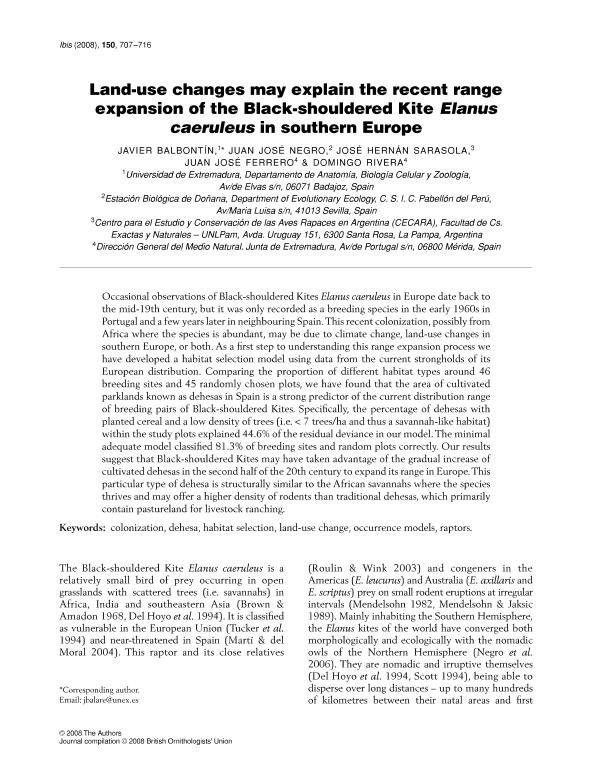Artículo
Land-use changes may explain the recent range expansion of the Black-shouldered Kite Elanus caeruleus in southern Europe
Balbontín, Javier; Negro Balmaseda, Juan José; Sarasola, José Hernán ; Ferrero, Juan José; Rivera, Domingo
; Ferrero, Juan José; Rivera, Domingo
 ; Ferrero, Juan José; Rivera, Domingo
; Ferrero, Juan José; Rivera, Domingo
Fecha de publicación:
10/2008
Editorial:
Wiley Blackwell Publishing, Inc
Revista:
Ibis
ISSN:
0019-1019
Idioma:
Inglés
Tipo de recurso:
Artículo publicado
Clasificación temática:
Resumen
Occasional observations of Black-shouldered Kites Elanus caeruleus in Europe date back to the mid-19th century, but it was only recorded as a breeding species in the early 1960s in Portugal and a few years later in neighbouring Spain. This recent colonization, possibly from Africa where the species is abundant, may be due to climate change, land-use changes in southern Europe, or both. As a first step to understanding this range expansion process we have developed a habitat selection model using data from the current strongholds of its European distribution. Comparing the proportion of different habitat types around 46 breeding sites and 45 randomly chosen plots, we have found that the area of cultivated parklands known as dehesas in Spain is a strong predictor of the current distribution range of breeding pairs of Black-shouldered Kites. Specifically, the percentage of dehesas with planted cereal and a low density of trees (i.e. < 7 trees/ha and thus a savannah-like habitat) within the study plots explained 44.6% of the residual deviance in our model. The minimal adequate model classified 81.3% of breeding sites and random plots correctly. Our results suggest that Black-shouldered Kites may have taken advantage of the gradual increase of cultivated dehesas in the second half of the 20th century to expand its range in Europe. This particular type of dehesa is structurally similar to the African savannahs where the species thrives and may offer a higher density of rodents than traditional dehesas, which primarily contain pastureland for livestock ranching.
Palabras clave:
Colonization
,
Dehesa
,
Habitat Selection
,
Land-Use Change
,
Occurrence Models
,
Raptors
Archivos asociados
Licencia
Identificadores
Colecciones
Articulos(INCITAP)
Articulos de INST.D/CS D/L/TIERRA Y AMBIENTALES D/L/PAMPA
Articulos de INST.D/CS D/L/TIERRA Y AMBIENTALES D/L/PAMPA
Citación
Balbontín, Javier; Negro Balmaseda, Juan José; Sarasola, José Hernán; Ferrero, Juan José; Rivera, Domingo; Land-use changes may explain the recent range expansion of the Black-shouldered Kite Elanus caeruleus in southern Europe; Wiley Blackwell Publishing, Inc; Ibis; 150; 4; 10-2008; 707-716
Compartir
Altmétricas



